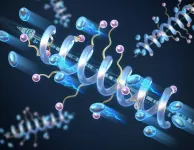(Press-News.org) Gene therapy could potentially cure genetic diseases but it remains a challenge to package and deliver new genes to specific cells safely and effectively. Existing methods of engineering one of the most commonly used gene-delivery vehicles, adeno-associated viruses (AAV), are often slow and inefficient.
Now, researchers at the Broad Institute of MIT and Harvard have developed a machine-learning approach that promises to speed up AAV engineering for gene therapy. The tool helps researchers engineer the protein shells of AAVs, called capsids, to have multiple desirable traits, such as the ability to deliver cargo to a specific organ but not others or to work in multiple species. Other methods only look for capsids that have one trait at a time.
The team used their approach to design capsids for a commonly used type of AAV called AAV9 that more efficiently targeted the liver and could be easily manufactured. They found that about 90 percent of the capsids predicted by their machine learning models successfully delivered their cargo to human liver cells and met five other key criteria. They also found that their machine learning model correctly predicted the behavior of the proteins in macaque monkeys even though it was trained only on mouse and human cell data. This finding suggests that the new method could help scientists more quickly design AAVs that work across species, which is essential for translating gene therapies to humans.
The findings, which appeared recently in Nature Communications, come from the lab of Ben Deverman, institute scientist and director of vector engineering at the Stanley Center for Psychiatric Research at the Broad. Fatma-Elzahraa Eid, a senior machine learning scientist in Deverman’s group, was the first author on the study.
“This was a really unique approach,” Deverman said. “It highlights the importance of wet lab biologists working with machine learning scientists early to design experiments that generate machine learning enabling data rather than as an afterthought.”
Group leader Ken Chan, graduate student Albert Chen, research associate Isabelle Tobey, and scientific advisor Alina Chan, all in Deverman’s lab, also contributed significantly to the study.
Make way for machines
Traditional approaches for designing AAVs involve generating large libraries containing millions of capsid protein variants and then testing them in cells and animals in several rounds of selection. This process can be costly and time-consuming, and generally results in researchers identifying only a handful of capsids that have a specific trait. This makes it challenging to find capsids that meet multiple criteria.
Other groups have used machine learning to expedite large-scale analysis, but most methods optimized proteins for one function at the expense of another.
Deverman and Eid realized that datasets based on existing large AAV libraries weren’t well suited for training machine learning models. “Instead of just taking data and giving it to machine learning scientists we thought, ‘What do we need to train machine learning models better?’” Eid said. “Figuring that out was really instrumental.”
They first used an initial round of machine learning modeling to generate a new moderately sized library, called Fit4Function, that contained capsids that were predicted to package gene cargo well. The team screened the library in human cells and mice to find capsids that had specific functions important for gene therapy in each species. They then used that data to build multiple machine learning models that could each predict a certain function from a capsid’s amino acid sequence. Finally, they used the models in combination to create “multifunction” libraries of AAVs optimized for multiple traits at once.
The future of protein design
As proof of concept, Eid and other researchers in Deverman’s lab combined six models to design a library of capsids that had multiple desired functions, including manufacturability and the ability to target the liver across human cells and mice. Almost 90 percent of these proteins displayed all of the desired functions simultaneously.
The researchers also found that the model — trained only on data from mice and human cells — correctly predicted how AAVs distributed to different organs of macaques, suggesting that these AAVs do this through a mechanism that translates across species. That could mean that in the future, gene therapy researchers could more quickly identify capsids with multiple desirable properties for human use.
In the future, Eid and Deverman say their models could help other groups create gene therapies that either target or specifically avoid the liver. They also hope that other labs will use their approach to generate models and libraries of their own that, together, could form a machine-learning atlas: a resource that could predict the performance of AAV capsids across dozens of traits to accelerate gene therapy development.
***
Funding
This work was supported in part by the Stanley Center for Psychiatric Research, Apertura Gene Therapy, and the National Institute of Neurological Disorders and Stroke and the National Institute of Mental Health at the National Institutes of Health.
Paper cited
Eid F E et al. Systematic multi-trait AAV capsid engineering for efficient gene delivery. Nature Communications. Online August 4, 2024. DOI: 10.1038/s41467-024-50555-y.
About Broad Institute of MIT and Harvard
Broad Institute of MIT and Harvard was launched in 2004 to empower this generation of creative scientists to transform medicine. The Broad Institute seeks to describe the molecular components of life and their connections; discover the molecular basis of major human diseases; develop effective new approaches to diagnostics and therapeutics; and disseminate discoveries, tools, methods and data openly to the entire scientific community.
Founded by MIT, Harvard, Harvard-affiliated hospitals, and the visionary Los Angeles philanthropists Eli and Edythe L. Broad, the Broad Institute includes faculty, professional staff and students from throughout the MIT and Harvard biomedical research communities and beyond, with collaborations spanning over a hundred private and public institutions in more than 40 countries worldwide.
END
Machine learning approach helps researchers design better gene-delivery vehicles for gene therapy
The method could accelerate the development of more effective adeno-associated viruses (AAVs).
2024-08-08
ELSE PRESS RELEASES FROM THIS DATE:
Bacteria encode hidden genes outside their genome—do we?
2024-08-08
NEW YORK, NY (Aug. 8, 2024) -- Since the genetic code was first deciphered in the 1960s, our genes seemed like an open book. By reading and decoding our chromosomes as linear strings of letters, like sentences in a novel, we can identify the genes in our genome and learn why changes in a gene’s code affect health.
This linear rule of life was thought to govern all forms of life—from humans down to bacteria.
But a new study by Columbia researchers shows that bacteria break that rule and can create free-floating and ephemeral genes, raising the possibility that similar genes exist outside ...
Assistant professor's $1.1M NASA grant to develop computational tool aiding hypersonic vehicle design
2024-08-08
STARKVILLE, Miss.—NASA is awarding a Mississippi State University assistant professor a $1.13 million grant to develop a new simulation tool to aid the design of hypersonic vehicles used in space exploration.
Vilas Shinde of MSU’s Department of Aerospace Engineering won the grant to develop a new flow stability and transition analysis tool, which will aid researchers and aircraft designers in understanding and predicting changes associated with the boundary layer—air flow in the vicinity of an aircraft’s ...
Houston Methodist study shows new, more precise way to deliver medicine to the brain
2024-08-08
Houston Methodist researchers have discovered a more accurate and timely way to deliver life-saving drug therapies to the brain, laying the groundwork for more effective treatment of brain tumors and other neurological diseases.
In a study published this month in Communications Biology, an open access journal from Nature Portfolio, investigators used an electric field to infuse medicine from a reservoir outside the brain to specific targets inside the brain. This adds a new dimension to the 30-year-old process of injecting therapeutics into the brain through ...
A ‘thank you’ goes a long way in family relationships
2024-08-08
URBANA, Ill. – You’ve probably heard that cultivating gratitude can boost your happiness. But in marriage and families, it’s not just about being more grateful for your loved ones — it’s also important to feel appreciated by them. Researchers at the University of Illinois Urbana-Champaign have previously explored the positive impact of perceived gratitude from romantic partners for couples’ relationship quality. In a new study, they show the benefits of perceived gratitude ...
How a legal loophole allows unsafe ingredients in US foods
2024-08-08
The Food and Drug Administration (FDA) is tasked with overseeing the safety of the U.S. food supply, setting requirements for nutrition labeling, working with companies on food recalls, and responding to outbreaks of foodborne illness. But when it comes to additives already in our food and the safety of certain ingredients, FDA has taken a hand-off approach, according to a new article in the American Journal of Public Health.
The current FDA process allows the food industry to regulate itself when it comes to thousands of added ...
USC researchers develop AI model that predicts the accuracy of protein–DNA binding
2024-08-08
A new artificial intelligence model developed by USC researchers and published in Nature Methods can predict how different proteins may bind to DNA with accuracy across different types of protein, a technological advance that promises to reduce the time required to develop new drugs and other medical treatments.
The tool, called Deep Predictor of Binding Specificity (DeepPBS), is a geometric deep learning model designed to predict protein–DNA binding specificity from protein–DNA complex structures. DeepPBS ...
Increasing solid-state electrolyte conductivity and stability using helical structure
2024-08-08
Solid-state electrolytes have been explored for decades for use in energy storage systems and in the pursuit of solid-state batteries. These materials are safer alternatives to the traditional liquid electrolyte—a solution that allows ions to move within the cell—used in batteries today. However, new concepts are needed to push the performance of current solid polymer electrolytes to be viable for next generation materials.
Materials science and engineering researchers at the University of Illinois Urbana-Champaign have explored the role of helical secondary structure on the conductivity of solid-state peptide polymer ...
The threat of mpox has returned, but public knowledge about it has declined
2024-08-08
PHILADELPHIA – It has been two years since the World Health Organization declared a global health emergency over an outbreak of mpox, a disease endemic to Africa that had spread to scores of countries. Now, in the summer of 2024, a deadlier version of the infectious disease has spread from the Democratic Republic of Congo to other African nations, the strain that originally hit the United States has shown signs of a resurgence, and this week the Centers for Disease Control and Prevention (CDC) issued a new alert on mpox to health care providers.
But while the American public quickly learned about the disease during the summer of 2022, as ...
How does traumatic brain injury progress to Alzheimer’s disease?
2024-08-08
RIVERSIDE, Calif. -- A traumatic brain injury, or TBI, is caused by a contusion to the head that may result in injury to the brain. This type of injury combined with the inherited genetic risk factors can result in the accelerated development of Alzheimer’s disease and related dementia, or ADRD. TBIs range from mild to severe, with the majority being mild. They are especially common in adolescents engaging in contact sports and in the elderly who tend to fall with greater frequency as they age. Regardless of the source, TBI and how it progresses to ADRD is an understudied area of research.
A $3.5 million grant to the University of California, ...
Researchers find unexpectedly large methane source in overlooked landscape
2024-08-08
When Katey Walter Anthony heard rumors of methane, a potent greenhouse gas, ballooning under the lawns of fellow Fairbanks residents, she nearly didn’t believe it.
“I ignored it for years because I thought ‘I am a limnologist, methane is in lakes,’” she said.
But when a local reporter contacted Walter Anthony, who is a research professor at the Institute of Northern Engineering at University of Alaska Fairbanks, to inspect the waterbed-like ground at a nearby golf course, she started to pay attention. Like others in Fairbanks, they lit “turf bubbles” on fire and confirmed the presence of methane ...
LAST 30 PRESS RELEASES:
Numbers in our sights affect how we perceive space
SIMJ announces global collaborative book project in commemoration of its 75th anniversary
Air pollution exposure and birth weight
Obstructive sleep apnea risk and mental health conditions among older adults
How talking slows eye movements behind the wheel
The Ceramic Society of Japan’s Oxoate Ceramics Research Association launches new international book project
Heart-brain connection: international study reveals the role of the vagus nerve in keeping the heart young
Researchers identify Rb1 as a predictive biomarker for a new therapeutic strategy in some breast cancers
Survey reveals ethical gaps slowing AI adoption in pediatric surgery
Stimulant ADHD medications work differently than thought
AI overestimates how smart people are, according to HSE economists
HSE researchers create genome-wide map of quadruplexes
Scientists boost cell "powerhouses" to burn more calories
Automatic label checking: The missing step in making reliable medical AI
Low daily alcohol intake linked to 50% heightened mouth cancer risk in India
American Meteorological Society announces Rick Spinrad as 2026 President-Elect
Biomass-based carbon capture spotlighted in newly released global climate webinar recording
Illuminating invisible nano pollutants: advanced bioimaging tracks the full journey of emerging nanoscale contaminants in living systems
How does age affect recovery from spinal cord injury?
Novel AI tool offers prognosis for patients with head and neck cancer
Fathers’ microplastic exposure tied to their children’s metabolic problems
Research validates laboratory model for studying high-grade serous ovarian cancer
SIR 2026 delivers transformative breakthroughs in minimally invasive medicine to improve patient care
Stem Cell Reports most downloaded papers of 2025 highlight the breadth and impact of stem cell research
Oxford-led study estimates NHS spends around 3% of its primary and secondary care budget on the health impacts of heat and cold in England
A researcher’s long quest leads to a smart composite breakthrough
Urban wild bees act as “microbial sensors” of city health.
New study finds where you live affects recovery after a hip fracture
Forecasting the impact of fully automated vehicle adoption on US road traffic injuries
Alcohol-related hospitalizations from 2016 to 2022
[Press-News.org] Machine learning approach helps researchers design better gene-delivery vehicles for gene therapyThe method could accelerate the development of more effective adeno-associated viruses (AAVs).



